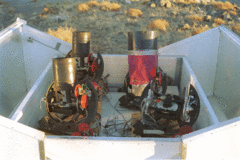
Services:
Catalogues
ACVS / variables
AASC / photometry
Sky Atlas
Kepler FOV
Download Data
View Alerts
Star of the Month
Information:
Credit
Status
Papers
History
Visitors so far: 354587.
| Location | Chile, LCO |
|---|---|
| Latitude | 29.01°S |
| Longitude | 70.70139°W |
| Altitude | 2215 m |
| # of t-scopes | 2 |
| Filters | V, I |
| Lens | 200/2.8 (Minolta) |
| FoV | 8.5° x 8.5° |
| CCD | 2048 x 2048 (AP-10) |
| Exp. time | 180s |
| # of V frames | > 334,000 |
| # of I frames | > 282,000 |

The ASAS-3 system was installed in the 10-inch astrograph dome
of the Las Campanas Observatory in August 2000.
It consisted of two wide-field telescopes, each equipped with 200/2.8 Minolta telephoto lens and 2Kx2K AP-10 CCD camera (made by Apogee Inc), cover 8.8x8.8 deg of the sky through the V and I filters; and of one narrow-field telescope: F=750mm, D=250mm, F/3.3 which is a Cassegrain-like instrument with 3-element Wyne corrector. It has the same 2Kx2K AP-10 CDD camera and I filter. FOV is 2.2x 2.2 deg, but correct PSF (FWHM < 2.5 pixels) is currently available only inside the circular field of ~1 deg radius.
In April 2002 the ASAS-3 system has moved to the new automated enclosure
in which all four instruments were installed.
The fourth one is a very-wide-field telescope equipped with the 50 mm
lens and another AP-10 camera. It features 36x26 deg. FOV and observes
only a few selected fields in purpose to test instrument sensitivity
for fast transient events.
The new enclosure was made at the Warsaw University shops. It's main feature is lightweigth clam-shell which two parts swing to the sides opening the sky to the ~20 deg. above horizon. Shells are driven by off-the-shelf gate-motors. Inside the enclosure there is a stable rack housing computers on its bottom level and telescopes on the upper.
Here you can find photographs of the ASAS-3 hardware.This system is directly connected to the BACODINE network and is ready for immediate follow-up observations of GRB events.